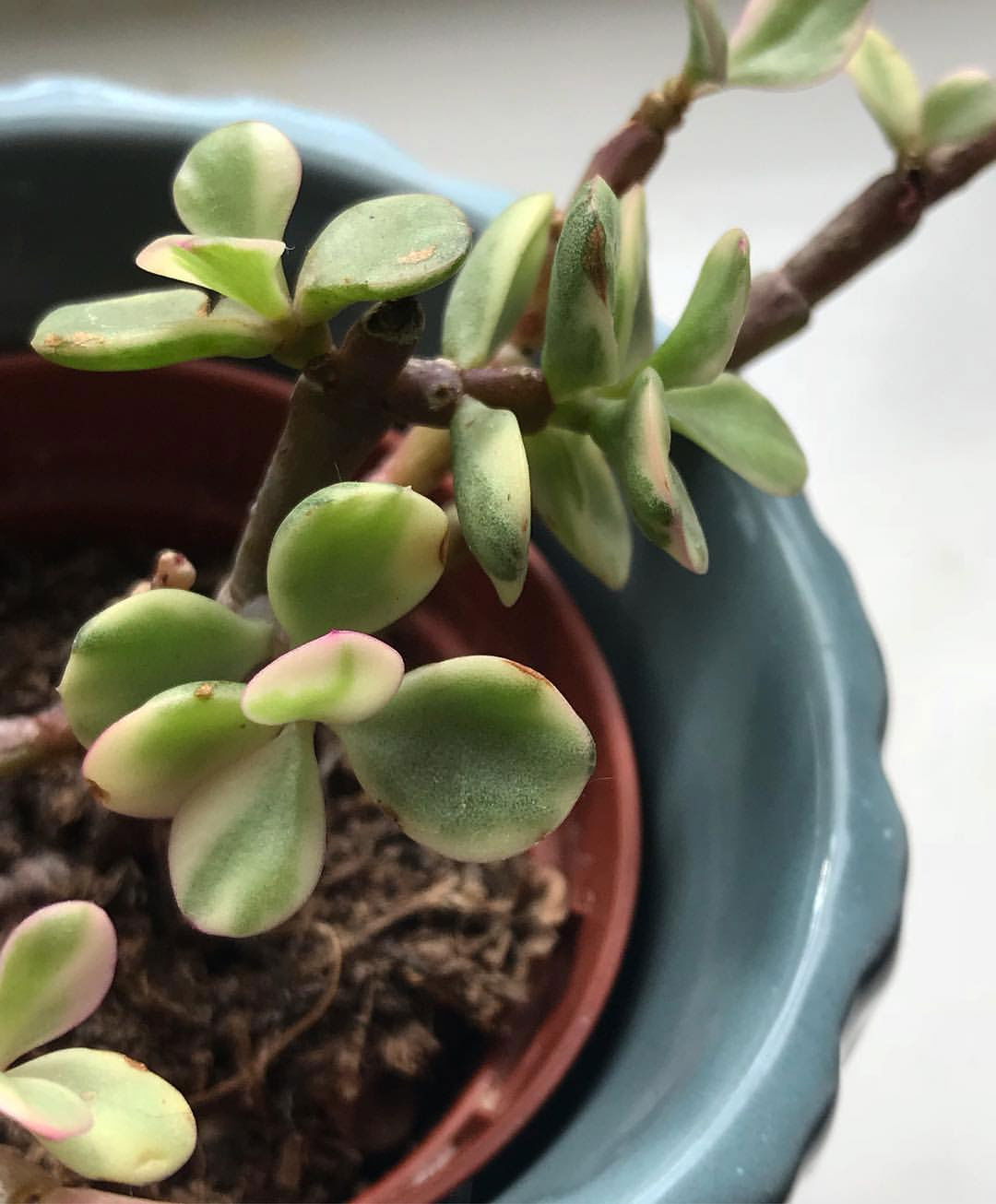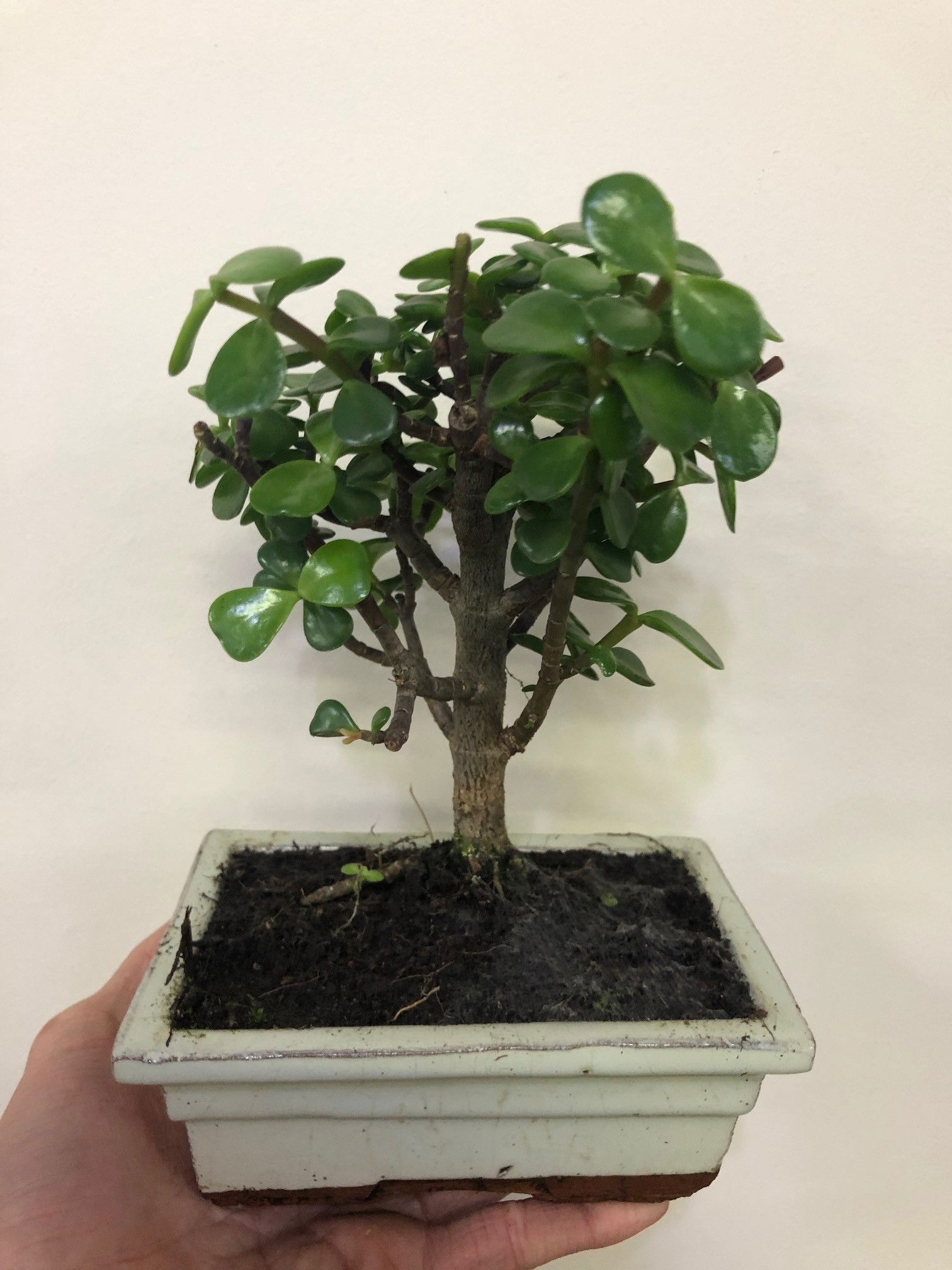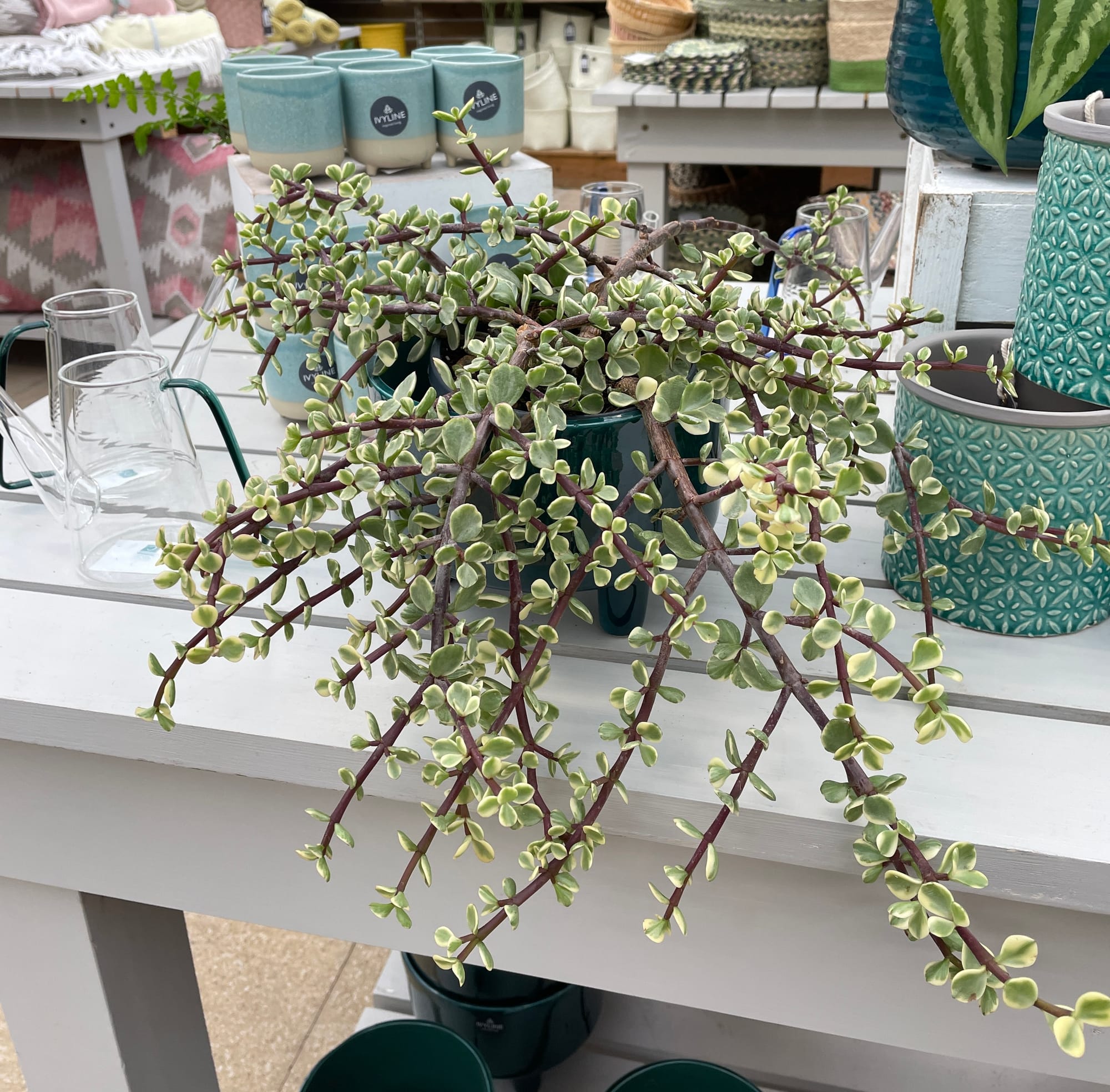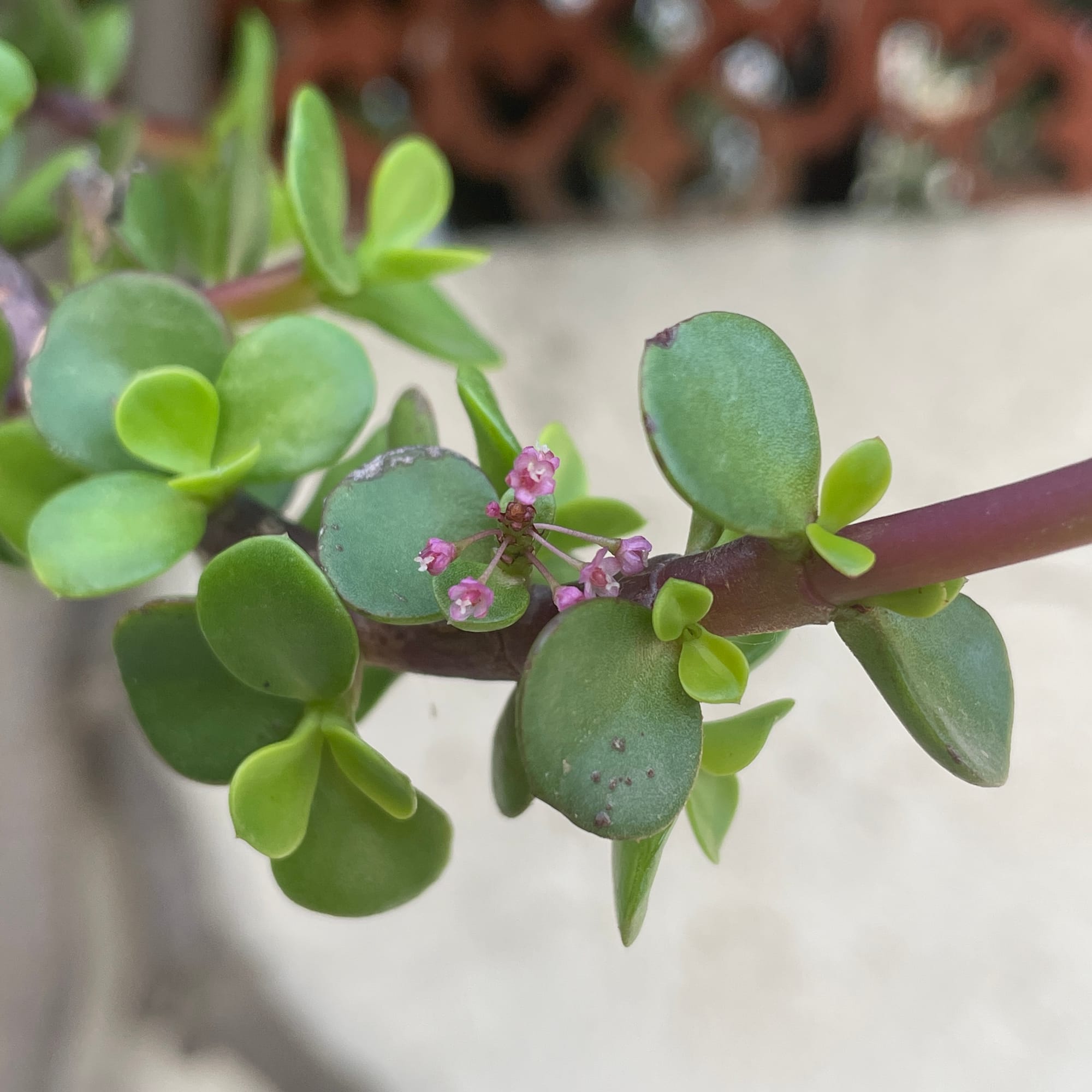
Portulacaria afra 'Variegata'
Contents
- Top Tips
- Location, Water, Humidity & Fertilisation
- Common Issues
- Origins, Temperature, Propagation, Repotting & Toxicity.
Need the answer to a specific plant query? Book a 1-to-1 video call with THE HOUSEPLANT DOCTOR™, the website's friendly author to overcome and address your niggling problem! Available on iMessage, WhatsApp, Facebook Messenger & more.
Top Tips & Info
- Care Difficulty - Moderate
- Provide a bright area with the possibility of morning sunlight. We'd recommend a windowsill or conservatory as a possible location for this species, as deep shade may result in soil mould and root rot.
- Allow all of the soil to dry out in between waters for the prevention of root rot. If you're stuck with when to water it, think of the ukhouseplants' phrase of 'Drenches Between Droughts'.
- Fertilise every two or three months using either a 'Cactus' or 'Houseplant' labelled feed.
- Repot every two or three years during the spring, using a 'Cactus & Succulent' potting mix and the next sized pot with drainage holes.
- Keep an eye out for Mealybugs that can inhabit the cubbyholes of the stem and leaves.
Location & Light - 🔸🔸🔸
Elephant Bushes like a relatively bright location that offers a few hours of off-peak sunlight. Exposure to the sun will not only reduce the risk of over-watering, but it'll also maintain the colourful variegations of its foliage. Due to its intolerance of low light, situations, where a newspaper can't be read without the use of artificial light, must be avoided at all costs.
If you've recently purchased a specimen, chances are it hasn't acclimatised to the potential direct sunlight you'll give it. If you're interested in placing yours in a brighter environment, gradually increase the light levels over the course of a few weeks to prevent the risk of environmental shock or sun-scorch.
Water - 🔸
In its natural habitat of southern Africa, Elephant Bushes must endure torrential downpours between prolonged dry spells to survive. Keeping this in mind, rehydrate only once the soil's entirety has thoroughly dried out, reducing this further in the autumn and winter. If you have trouble knowing when to water appropriately, remember the ukhouseplants phrase; 'drenches between droughts'. For some varieties, pouring cold water directly into the soil could cause yellowed halos around the leaf edges that cannot be undone. Store tap water overnight in a non-metal container to bunk up the overall temperature, or use rainwater for the best results. Under-watering symptoms include shrivelling leaves and stems, little to no growth, gradual decline; these issues are usually caused by too much light or heat, a much needed repot or possible forgetfulness. Over-watering symptoms include yellowing leaves, a collapsed stem, wilting and plant death. Never situate yours in a dark location; the combination of both too little light and too much soil moisture will slowly lead to root rot.
Humidity -
This is not a necessity; however, a quick hose down from time to time will hydrate the leaves and wash away dust or potential pests.
Fertilisation - 🔸
Fertilise every two months during the growing period and every three months in the autumn & winter to replicate its dormancy period. Although a 'Houseplant' fertiliser will still do the job, we'd recommend using a specific 'Cactus' labelled feed as it'll support the vital thirteen nutrients that this species will need to grow.
Common Issues with Elephant Bushes
Reddened leaves are the product of too much sunlight, most common during the height of summer. A pigmentation called 'Carotenoids' will alter the appearance of your plant to counteract the harsh effects of the UV rays. This doesn't mean it'll die, it just a behaviour to keep it from burning in the sun. THE HOUSEPLANT DOCTOR™ recommends to relocate in another windowsill that offers indirect sunlight, like a north-west, north or north-east facing window.
Alternatively, root rot is a common issue among specimens sat in too dark environments with prolonged soil moisture. Symptoms include rapidly yellowing leaves, mouldy soil, stunted growth and a rotten brown base. Take the plant out of the pot and inspect health below the compost line. If the roots sport a yellow tinge, you're good to go, but those that are brown and mushy must be addressed immediately. More information about addressing root rot can be found on this link.
Clean the leaves regularly. Although this isn't too much of an issue, a build-up of dust particles can clog up the plant's pores, causing lowered light capturing-efficiency. Rinse the topsides of the leaves down once a month to keep levels down and improve growing conditions.
Never allow temperatures to dip below 10ºC (50ºF) as irreversible damage will occur in the likes of yellow foliage and weakened health. When this happens, remove the severely affected areas and immediately improve growing conditions - never cut through softened yellow or brown growth. As rehabilitation can take several months because of its slow-growing nature, be sure to provide a stable location with better growing conditions to speed this process.
Failed propagated stem cuttings - There are several reasons why the cuttings haven't rooted well, including: the time of year (spring or summer is best), its size (Portulacaria cuttings should have at least three leaves), poor growing conditions (replace water weekly for water-propagated cuttings, and avoid over-watering for soil-grown plants), and its growing environment (a bright sunless windowsill and warmth is important).
Origins
Portulacaria is a genus consisting over ten species with natural distributions in Southern Africa. Its name derives from Latin, with portula translating to 'door' that refers to the opening lid of its fruits. Caria means 'relating to', which is a reference to the similarity of the genus, Portulaca. The species' name, afra, is a specific epithet to the continent of Africa. Many animals, including ostriches and elephants, feast on the sour-tasting foliage for nutrition. The species' leaves are also classed as a local delicacy, being used in salads and soups.
 Image 2: The Distribution of Portulacaria afra.
Image 2: The Distribution of Portulacaria afra.
Temperature
10° - 26°C (50° - 78°F)
H1b (Hardiness Zone 12) - Can be grown outdoors during the summer in a sheltered location with temperatures above 12℃ (54℉), but is fine to remain indoors, too. If you decide to bring this plant outdoors, don't allow it to endure any direct sunlight as it may result in sun-scorch and dehydration. Regularly keep an eye out for pests, especially when re-introducing it back indoors.
Spread
Up to 2m in height and 1.5m in width if repotted every other year. The ultimate height will take between 5 - 10 years to achieve, but can live for up to 20 years or more in the right care.
Pruning & Maintenance (Bonsai Shaping)
In terms of maintaining a healthy plant, remove yellow or dying leaves with a clean pair of scissors or secateurs. Any healthy portions of the stem that are accidentally broke off can be propagated as cuttings if longer than 5cm (2 inches).
Formal Upright (Image Below)
1. To start-up, we recommend taking an upright straight stem cutting from a healthy plant.
2. Dip the cutting's wound in rooting gel before placing it in a 7cm plastic pot with a 'Cactus & Succulent' soil. Keep the cutting on the dry side, misting the foliage every two days. Ensure it's kept in a bright, sunless windowsill with warmth above 18°C (64°F).
3. Allow the cutting to grow freely for the next twelve months, pinching off any side shoots that emerge lower down on its stem. The aim is to have a long, tall shaft that'll be the specimen's main trunk.
4. After one year, allow any offset branches to grow that emerge in the top half of the stem. Once the offsets are around 10cm in length, use Bonsai wire to guide them outwards, instead of growing upwards like the main stem.
5. Once the main stem's diameter is at least 1.5cm+ (0.75in+), reduce its length to just 25cm in height to produce a globular cluster of smaller branches (forming a lolly-pop shape).
6. Guide any vertically growing branches and reapply more Bonsai wire if needed to create the lolly shape.
7. Your Bonsai should look a little like the tree pictured below. Maintain the shape by allowing all stems to grow outwards around 3-5cm (2 inches) annually, before pinching off any extra growth for that calendar year. Loosen off any Bonsai wire once the overall shape has been completed.
 Image 3: 'Formal Upright' Bonsai Style (Chokkan)
Image 3: 'Formal Upright' Bonsai Style (Chokkan)
Semi Cascade (Image Below)
Chances are, a commercially grown Portulacaria may already look like the plant below. If this is the case, why not purchase one and embrace its cascading appearance?
The best location for its growth is either on a windowsill or under a grow light. We also recommend allowing the stems to grow freely for the first year of ownership to avoid plant-shock. Branches that begin to vertically grow can be trained downwards by using Bonsai wire (also available at most garden centres). Choose a general direction for the branches to grow, as it'll look more tidy when styled one way (like someone's hair fringe would) and not randomly across all directions from the pot.
Once the plant is your desired size, prune each stem back by a fifth during the spring time to promote a bushier appearance. If a pruning is greater than 5cm in length, feel free to propagate it by following the information below. Once rooted, these cuttings can be re-inserted back into the mother plant's soil to thicken the overall foliage near its base.
 Image 4: 'Semi Cascade' Bonsai Style (Han-kengai)
Image 4: 'Semi Cascade' Bonsai Style (Han-kengai)
Propagation
Stem Cuttings (Easy) - Using a clean pair of scissors, cut a 5-10cm (2-4 inch) section from the tip of a stem of your choice. Be sure to use a fresh, damage or pest-free piece as unhealthy branches are more likely to fail. Remove the older half of the leaves, so the stem's half is bare to speed the process of root development. Purchase a 'Cactus & Succulent' compost and vertically push the cutting's base into the soil, avoiding the risk of covering the foliage with soil. Situate the cutting in a sunless windowsill with temperatures above 18°C (64°F) and mist the plant and top layer of the soil every two days with warm water. The root system will develop first before its leaves, so as soon as new leaves emerge you can treat it as a mature specimen.
Flowers
See Image 2 for its flowers. During mid-summer, matured specimens can produce small clusters of pink or white scented flowers that are around 2mm in size, lasting up to several weeks. Elephant Bushes won't flower in a domestic setting for many years due to the unfavourable growing conditions and time in which it takes to reach maturity.
 Image 5: Mature Elephant Bush plants will produce small bundles of flowers during the warmer months of the year.
Image 5: Mature Elephant Bush plants will produce small bundles of flowers during the warmer months of the year.
Repotting
During the spring, repot every two or three years using a 'Cactus & Succulent' potting mix and the next sized pot with drainage. This is an excellent time to check the roots' condition, as well as propagation if you desire. As Elephant Bushes are prone to root rot, have a look around the bottom half of the root ball for any brown or broken down roots caps. If this is the case, remove the affected areas with clean utensils and ease off with the irrigations; click on this link to learn more about how to perform the perfect transplant.
Book a 1-to-1 video call with Joe Bagley if you'd like a personal guide to repotting your houseplant. This will include recommending the right branded-compost and pot size, followed by a live video call whilst you transplant the specimen for step-by-step guidance and answer any further questions!
Pests & Diseases
Keep an eye out for mealybugs, scale, whitefly, vine weevils & root mealybugs that'll locate themselves in the cubbyholes and undersides of the leaves, with the exception of the latter two in the soil. Common diseases associated with Elephant Bushes are root rot, botrytis, rust, powdery mildew & southern blight - click here to learn more about these issues.
Toxicity
Not known to be poisonous when consumed by pets and humans. If large quantities are eaten, it may result in vomiting, nausea and a loss of appetite.
Retail Locations
Blue Diamond, Dobbies & Online Stores.
Book a 1-to-1 Call with THE HOUSEPLANT DOCTOR™
If you need further advice with your houseplants, book an advice call with ukhouseplants' friendly and expert writer today! This can be done via a video or audio call on most apps, including Facebook, FaceTime & Skype. A ten-minute call costs £5.99 (US$7), or £15.99 for thirty minutes. You can ask multiple questions, including queries on plants, pests, terrariums, repotting advice and anything in between. Please consider supporting this service to keep ukhouseplants thriving!